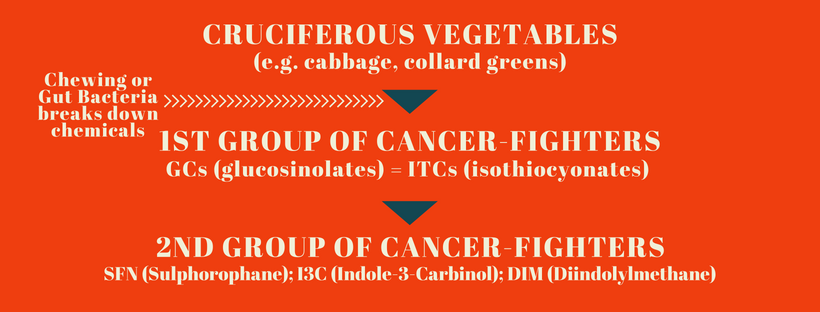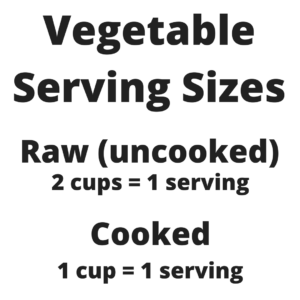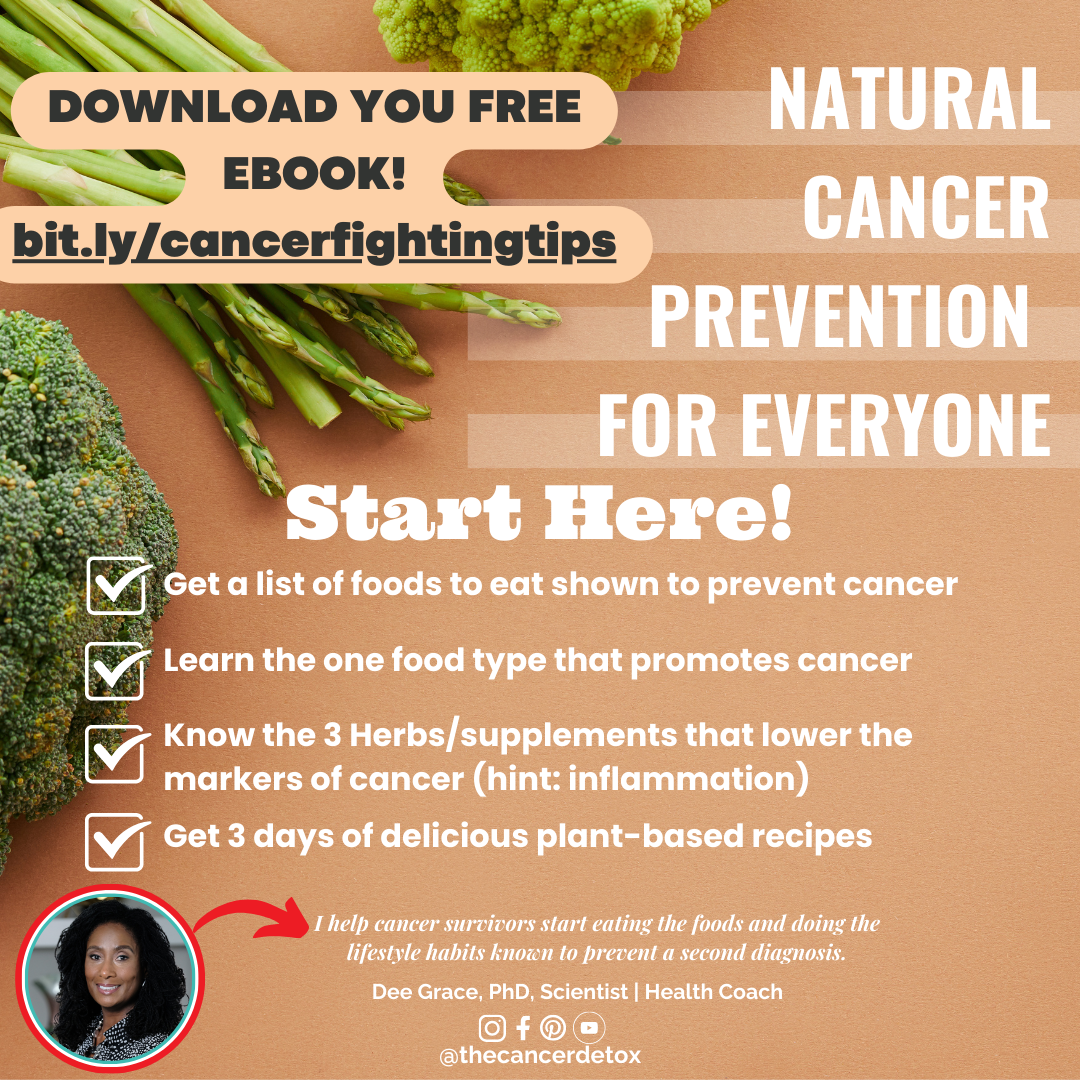10 Cancer Fighting Vegetables You Need to Eat Every Day
NOTE: Our instant download “7 Natural Cancer Fighting Tips” is a great companion to this article.
Everywhere I go I hear genuine concern from people about what appears to be an increasing rate of cancer. Most of the concern centers around why younger people and African American women seem to have higher rates of cancers. In the end, I’m always asked what can be done to combat this. So many factors go into cancer development but growing scientific evidence shows more fruits and vegetables, especially cancer fighting vegetables, are key to preventing cancer.
What Are the 10 Cancer-Fighting Vegetables?
So what exactly are these vegetables? The 10 vegetables listed below are in the cruciferous vegetable family (pronounced crew-sif-er-us) also known as Brassicaceae, and they cause changes in the body that fight off cancer.
- Cabbage (red and green)
- Cauliflower
- Bok choy
- Turnips
- Watercress
- Brussel Sprouts
- Broccoli
- Mustard Greens
- Collard Greens
- Turnip Greens
How Do These Vegetables Work?
Hundreds of scientific studies have been published on these cancer-fighting vegetables. Most are lab studies but human studies have started to be published looking at how cruciferous vegetables fight against new cancers and cancer recurrence. The results from these studies have uncovered several theories on how these vegetables protect against cancer and include:
- These vegetables contain cancer-fighting chemicals called GCs (glucosinolates). One type of GC is ITC (isothiocyanate). ITCs are one of THE top natural cancer-fighting chemicals found in vegetables today
- Chewing, as well as the bacteria in our guts, converts ITCs to the 2nd group of cancer-fighting chemicals called SFN (sulforaphane) and DIM (diindolylmethane). Your gut bacteria can also make SFN and DIM, however, it’s the chewing of the vegetables, releasing saliva and plant enzymes, that is most important in converting GCs to SFN and DIM. Chew these vegetables well!
Here’s a graphic on how this all works…

3. Once these plant chemicals are present they can turn on enzymes in the liver called phase 1 and phase 2 enzymes. These enzymes detox the body of cancer-causing toxins coming from the environment, especially plastics and pesticides. They also detox the body of growing tumors
4. ITCs work to kill growing cancer cells, a process known as “apoptosis.”
5. ITCs stop cancer cells from uncontrolled growth. They do this on a cellular level by forcing the cells out of their reproduction and division phases (cell cycle phases known as “G2” and “M” respectively)
6. ITCs improve hormone metabolism, particularly estrogen. When estrogen metabolism gets out of wack, there is more bad estrogen (2-hyrdroxyestrone) compared to good estrogen (16-hydroxyestrone) in the body. Bad estrogen feeds breast cancer as well as fibroid tumor growth. DIM is especially helpful in removing bad estrogen from the body
7. ITCs stop new blood vessels from forming (angiogenesis), which is important for cancer cells because the growing tumor needs a constant supply of fresh blood for nutrients
8. ITCs act as antioxidants that help fight inflammation and aging in the body. ITCs work on a cellular level to produce an enzyme that fights oxidation, which is known to promote tumor growth
How Many Vegetable Servings Should I Eat a Day?
Our goal at Bedside Manners is to urge people to eat more cruciferous vegetables. These grown “above ground,” low in starch and sugar, full of fiber, and high in natural cancer-fighting chemicals. Yes, root vegetables have health benefits (e.g. potatoes, beets, carrots), however, the most studied cancer-fighting vegetables are green and grown above the ground.
So no matter if you hate green vegetables or love them, here are some guidelines for you to follow to include more of these top 10 vegetables into your daily diet…
For Potato and Tomato Eaters:
You might scoff at anything green but don’t fret! Even though you’re currently eating no greens (maybe an occasional iceberg lettuce salad) that’s ok. We recommend you start out slow with ½ – 1 serving of the top 10 veggies a day. That’s only 1 – 2 cups (see below for serving amounts). You can easily get this amount in a green smoothie or on your lunch or dinner plate
For Sweet Vegetable Eaters (e.g. yellow squash, zucchini, corn, beet, carrots):
Chances are if you’re these types of vegetables you probably have a sweet tooth. The good news is that you’re getting fiber from these vegetables. However, you have room to grow so up your game by eating 2 servings of the top 10 vegetables a day. Add them to green juices or smoothies for breakfast and snacks, as well as on your lunch & dinner plates
For Spinach and Broccoli Eaters:
You’re what we like to call, “advanced vegetable eaters.” You eat leafy greens like spinach or broccoli but may not be eating them every day or just barely getting 1 serving in. You too can up your game by adding on 2 – 3 servings every day of the top 10 vegetables every day
How Much is in a Serving of Vegetables?
You can see below how many cups are in 1 serving of raw (uncooked) and cooked vegetables.

Are They Safe to Eat and Do They Help Cancer Patients?
Yes and maybe. They have been shown to be safe and they could possibly help those with cancer, as described below…
- SFN obtained from broccoli sprouts showed that it was safe with no bad effects when given to healthy people or women with breast cancer (1)
- One study in men with pancreatic ductal adenocarcinoma found that 90 mg/day of active SFN stopped tumor growth and enhanced the effects of chemotherapy that was being given to the men (2)
Key Take-Away’s
- Our top 10 vegetables are in the cruciferous vegetable family
- Cruciferous vegetables contain ITCs, which gets converted to SFN or DIM
- ITCS, SFN and DIM are well studied and known kill cancer cells, detox the body of cancerous cells, remove toxins, and change tumor metabolism
- Eating 1 serving of cruciferous vegetables a day is best to prevent cancer and may work to change cancer metabolism in those with cancer
To Your Best Health!
Dr. Dee Grace, PhD
Scientist and Patient Advocate
References
- Su X, et al. Anticancer activity of sulforophane: the epigenetic mechanisms and Nrf2 signaling pathway. Oxidative Med Cell Longevity. 2018 [epub]
- Lozanovski VJ, et al.“Pilot study evaluating broccoli sprouts in advanced pancreatic cancer (POUDER trial) – study protocol for a randomized controlled trial,” Trials, vol. 15, no. 1, p. 204, 2014
Need More Cancer-Fighting Tips?
7 Natural Cancer Fighting Tips
Conquer Cancer │Thrive│Prevent. Ready to #beatcancer? Bedside Manners provides cancer facts that empower cancer patients and survivors. Our science-based tips focus on natural cancer-fighting foods, cancer prevention techniques, and getting better healthcare after a cancer diagnosis.



